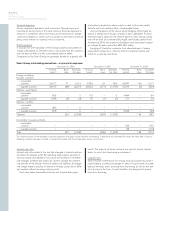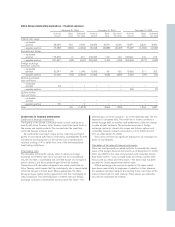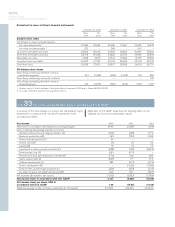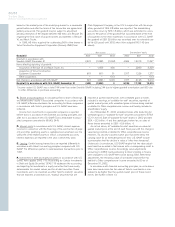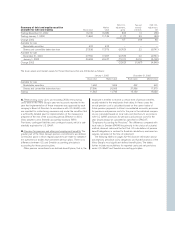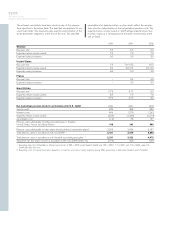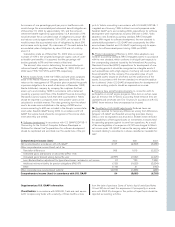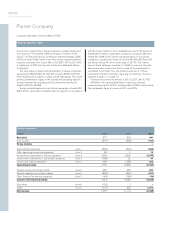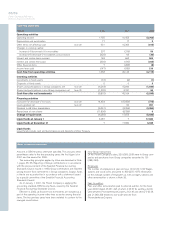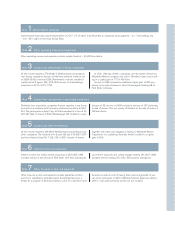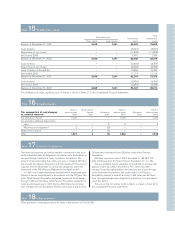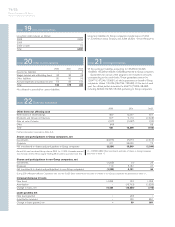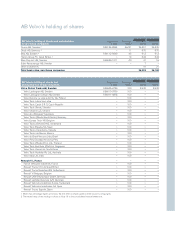Volvo 2002 Annual Report Download - page 67
Download and view the complete annual report
Please find page 67 of the 2002 Volvo annual report below. You can navigate through the pages in the report by either clicking on the pages listed below, or by using the keyword search tool below to find specific information within the annual report.
An increase of one percentage point per year in healthcare costs
would change the accumulated post-retirement benefit obligation as
of December 31, 2002 by approximately 191, and the net post-
retirement benefit expense by approximately 14. A decrease of 1%
would decrease the accumulated value of obligations by about 180
and reduce costs by approximately 13. In 2001, an increase of 1%
would increase the accumulated value of obligations by about 206
and increase costs by about 15; a decrease of 1% would reduce the
accumulated value of obligations by about 194 and cut costs by
about 14.
Calculations made as of December 31, 2002 show an annual
increase of 10% in the weighted average per capita costs of cover-
ed health-care benefits; it is assumed that the percentage will
decline gradually to 5% and then remain at that level.
The discount rates used in determining the accumulated post-
retirement benefit obligation as of December 31, 2000, 2001 and
2002 were 7.5%, 7.0-7.25% and 6.75%, respectively.
I. Alecta surplus funds. In the mid-1990s and later years surpluses
arose in the Alecta insurance company (previously SPP) since the
return on the management of ITP pension plan exceeded the growth
in pension obligations. As a result of decisions in December 1998,
Alecta distributed, company by company, the surpluses that had
arisen up to and including 1998. In accordance with a statement
issued by a special committee of the Swedish Financial Accounting
Standards Council, surplus funds that were accumulated in Alecta
should be reported in companies when their present value can be
calculated in a reliable manner. The rules governing how the refund
was to be made were established in the spring of 2000 and an
income amounting to 683 was included in the Group’s income state-
ment under Swedish GAAP during 2000. In accordance with U.S
GAAP, the surplus funds should be recognized in the income state-
ment when they are settled.
J. Software development. In accordance with U.S. GAAP (SOP 98–1
“Accounting for the Costs of Computer Software Developed or
Obtained for Internal Use”) expenditures for software development
should be capitalized and amortized over the useful lives of the pro-
jects. In Volvo’s accounting in accordance with U.S. GAAP, SOP 98–1
is applied as of January 1999. In Volvo’s accounts prepared under
Swedish GAAP up to and including 2000, expenditures for software
development were expensed as incurred. Effective in 2001, Volvo
adopted a new Swedish accounting standard, RR15 Intangible
assets. With regard to software development, the new standard is
substantially equivalent to U.S. GAAP and consequently the differ-
ence between Swedish and U.S. GAAP is pertaining only to expen-
ditures for software development during 1999 and 2000.
K. Product development. Effective in 2001, Volvo adopted a new
Swedish accounting standard, RR15 Intangible assets. In accordance
with the new standard, which conforms in all significant respects to
the corresponding standard issued by the International Accounting
Standards Committee (IASC), expenditures for development of new
and existing products should be recognized as intangible assets if
such expenditures with a high degree of certainty will result in future
financial benefits for the company. The acquisition value of such
intangible assets should be amortized over the useful lives of the
assets. In accordance with the new standard, no retroactive applica-
tion is allowed. Under U.S. GAAP, all expenditures for development of
new and existing products should be expensed as incurred.
L. Entrance fees, aircraft engine programs. In connection with its
participation in aircraft engine programs, Volvo Aero in certain cases
pays an entrance fee. In Volvo’s accounting these entrance fees are
capitalized and amortized over 5 to 10 years. In accordance with U.S.
GAAP, these entrance fees are expensed as incurred.
M. Tax effects of U.S. GAAP adjustments. Deferred taxes are
generally reported for temporary differences arising from differences
between U.S. GAAP and Swedish accounting principles. During
2002, a new tax legislation was enacted in Sweden which removed
the possibility to offset capital losses on investments in shares held
for operating purposes against income from operations. As a result
of the new legislation, a tax expense of 2,123 was charged to Volvo’s
net income under U.S. GAAP to reduce the carrying value of deferred
tax assets relating to investments in shares classified as “available-for-
sale".
Comprehensive income (loss) 2000 2001 2002
Net income (loss) in accordance with U.S. GAAP 3,127 (4,320) (6,265)
Other comprehensive income (loss), net of tax
Translation differences 966 1,015 (2,222)
Unrealized gains and (losses) on securities (SFAS 115):
Unrealized gains (losses) arising during the year (3,787) (1,532) (2,425)
Less: Reclassification adjustment for (gains) and losses included in net income (1) 733 7,558
Additional minimum liability for pension obligations (FAS 87) (132) (1,622) (3,234)
Other (119) 41 (165)
Other comprehensive income (loss), subtotal (3,073) (1,365) (488)
Comprehensive income (loss) in accordance with U.S. GAAP 54 (5,685) (6,753)
Supplementary U.S. GAAP information
Classification. In accordance with SFAS 95, “cash and cash equiva-
lents” comprise only funds with a maturity of three months or less
from the date of purchase. Some of Volvo’s liquid funds (see Notes
19 and 20) do not meet this requirement. Consequently, in accord-
ance with SFAS 95, changes in this portion of liquid funds should be
reported as investing activities.



